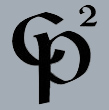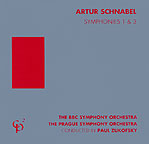
SYMPHONIES 1 & 3
THE BBC SYMPHONY ORCHESTRA
THE PRAGUE SYMPHONY ORCHESTRA
PAUL ZUKOFSKY, conductor

 |
ARTUR SCHNABEL SYMPHONIES 1 & 3 THE BBC SYMPHONY ORCHESTRA THE PRAGUE SYMPHONY ORCHESTRA PAUL ZUKOFSKY, conductor |
 |
With the release of this CD and CP2110, all of Artur Schnabel's Symphonies and other orchestral works have now been recorded, although the Piano Concerto (1899), and the Rhapsody for Orchestra (1947) exist only on long-out-of-print recordings. This CD (CP2109) presents Symphonies 1 & 3, with Symphony No. 2 being available on CP2104. Symphony No. 1 is not a work of Schnabel's either physical or compositional youth. Indeed, by the date of this symphony (1938), Schnabel (who was then 56) had already written two-thirds of his total production, including such major works as the 1914 Notturno for Voice and Piano, four (of the five) String Quartets, the Solo Violin Sonata (CP2110), the Violin and Piano Sonata (CP2102), the String Trio, the Cello Solo Sonata, the 1922 Piano Sonata, and the extraordinary Piano Piece in Seven Movements. On June 30, 1938, Schnabel wrote (from Tremezzo, Italy, to Mary Virginia Foreman) that he was "absorbed by the Symphony. I have finished the second movement of my new trying; it is a fascinating and fanciful little March, a 'Wanderlied', firm but soft." By July 25, the entire composition was finished, although not orchestrated, and Schnabel completed the orchestration in New York in October 1938. A massive work, Symphony No. 1 is scored for three flutes (the second and third doubling piccolo), three oboes, three clarinets, three bassoons (the third doubling contrabassoon), four horns, three trumpets, three trombones, five percussion, and strings. Structurally, the Symphony follows the four-movement-model previously laid out in the 1935 Violin and Piano Sonata, and both this Symphony and the Sonata helped shape the 1941-3 Symphony No. 2--in some instances, quite specifically (i.e. compare the openings of the third movements of Symphonies 1 and 2). Pitchwise, Symphony No. 1 uses various collections of six or seven pitches each, with the Dorian mode being one of the collections. These pitch collections spread over various interval ranges (major seventh, minor sixth or tritone, i.e. the elegiac trumpet solo of the third movement, played by William Hougton, is based within two ranges, each range spanning a tritone), and the collections are freely manipulated melodically, contrapuntally, and harmonically. Within these pitch collections, and especially within the opening motive, the intervals of a minor second and that of a perfect fifth play pivotal (indeed almost motival) roles. Symphony No. 1 was premiered in December 1946 (Saechinger's list is incorrect) with Dimitri Mitropoulos conducting the Minneapolis (now Minnesota) Symphony Orchestra. The Symphony was also performed in London in the spring of 1948. This was the only one of his symphonies that Schnabel ever heard. Symphony No. 1 is by far the densest of the Symphonies. In contrast, Symphony No. 3 is far more concise, far less declamatory, emphasizing free counterpoint over harmony, and in general having a phrasing and syntax far more segmented, almost bordering on the abrupt. If ever Schnabel was at his most prescient, and at the cusp of what was "in the air" (see my notes to Symphony No. 2) it is in the work that Symphony No. 1 is paired with on this CD. According to various letters, Symphony No. 3 (scored for winds by threes, four horns, four trumpets, three trombones, tuba, percussion, piano and strings) was written in the summer of 1948 (although the finished score bears dates between June 25 and September 11, 1949, with the designation Los Gatos). On July 7 (1948) Schnabel wrote (from Sils Maria) that he had started a "3rd Symphony"; and on July 19: "I have finished the first movement of the new symphony and written 2/3 of the second"; ...somewhat later: "I am on the last movement. It presents a special problem. Using an old tune of mine as its basis, I discovered the attractive, but often seemingly insoluble difficulty of combining the free use of musical material, which is the great advantage of so-called atonality, with the limited use of it, which to me, in the development of musical ideas, has become absolutely shop-worn, and which no trick of spicing can save from shallowness." The "old tune of mine" is the theme (played by Joseph Ruzicka (with thanks to JN for one D#)) of the last (i.e. second) movement of Schnabel's 1899 Piano Concerto (although the notation has been changed from a more propulsive 2/4 of the Piano Concerto to the 4/4 of the Symphony). Symphony No. 3 is one of the most metrically (and rhythmically) complex works that Schnabel ever wrote. To give some statistical feel for this aspect, I point out that the first movement of Symphony No. 3 is 202 bars in length, with 148 meter changes. Five bars is the longest length without a meter change, and these periods of momentary stasis occur only three times in the movement. The second movement, of length 156 bars, contains 83 meter changes, and even the last movement, despite being based on such a purportedly conventional theme, contains 125 meter changes. Embedded within all these meter changes are reasonably tricky rhythms, along with various metric modulations, other metronomic modifications and written emotional indications. As an example of a typical series, I cite the following consecutive 22 bars which begin at measure 138 of the first movement:
This farctate metric complexity can, in my opinion, best be explained as an attempt by Schnabel to return to the plasticity and freedom of the 1919 Solo Violin Sonata, with the qualifier being germane, as the orchestral context tends toward a limit, if only because one is obliged to more or less keep synchronous individual players and lines. Artur Schnabel never heard his Symphony No. 3. The premiere was scheduled for a concert on which Schnabel was supposed to perform a piano concerto. Schnabel died before the concert took place and, with the cancellation of the piano soloist, the orchestra and/or its management felt no need to honor the commitment to perform the Symphony. As evidence that history repeats itself, but as farce, Symphony No. 3 was next scheduled to receive its premiere in conjunction with this recording. Despite the concert review printed on page three of the Prague Telegraf of April 27, 1992, I can assure you that for various reasons (which I had nothing to do with, and shall therefore not detail, but I will refer the reader to Mozart's letter of Oct. 15-25, 1787) the concert never took place, although that minor detail did not prevent the favorable review of the phantom concert. It is my pleasure and privilege to state that Musical Observations, Inc. and I most gratefully acknowledge the existence and assistance of Mary Virginia Foreman Le Garrec, whose quiet persistence, coupled with immense generosity of both spirit and capital, has enabled us to accomplish all of the Schnabel Symphonic works that we have released. Our heartfelt THANKS. (PZ November, 1995)
Symphony No. 3 by Artur Schnabel was recorded April 23-29, 1992 at Smetana Hall, Prague, Czechoslovakia. CP2109 |
||||||||||||||||||||||||||||||||